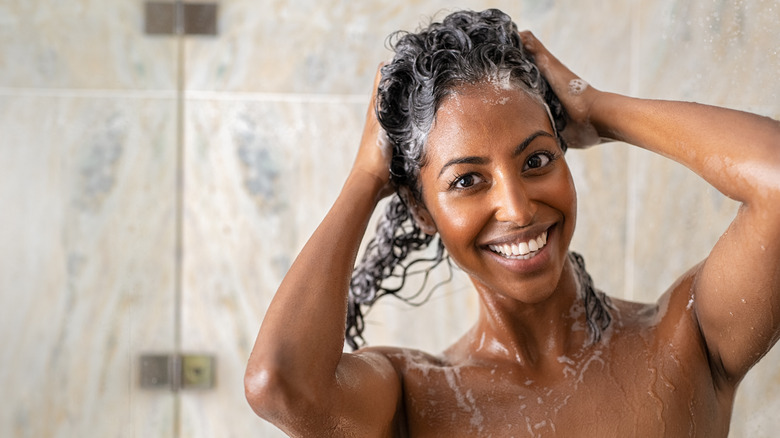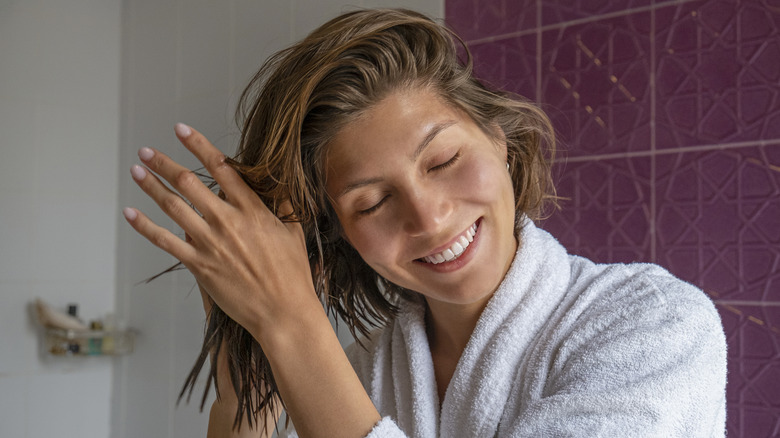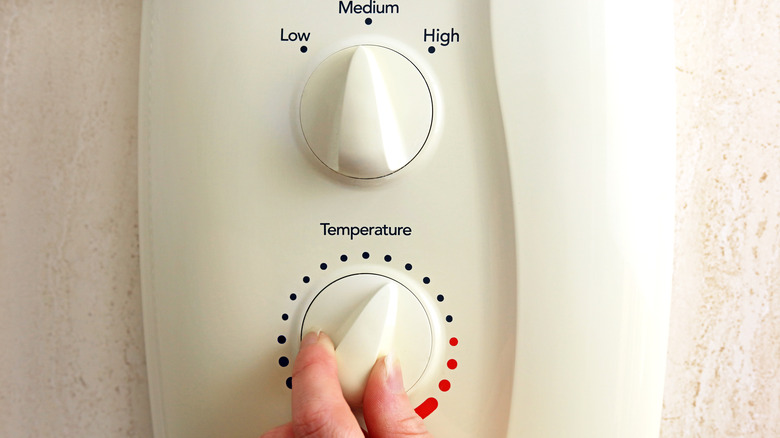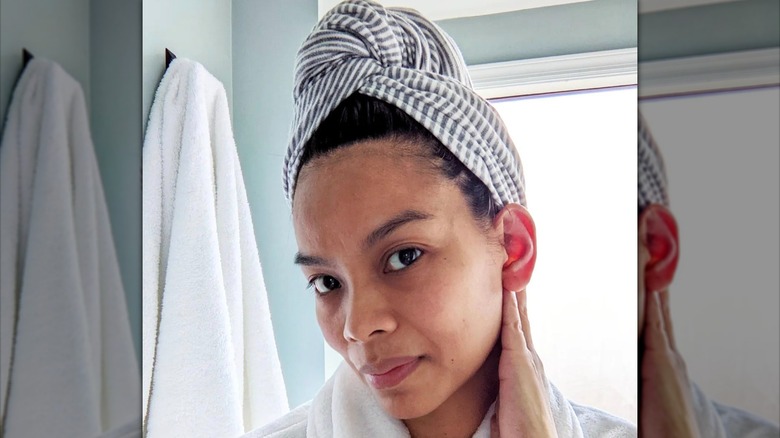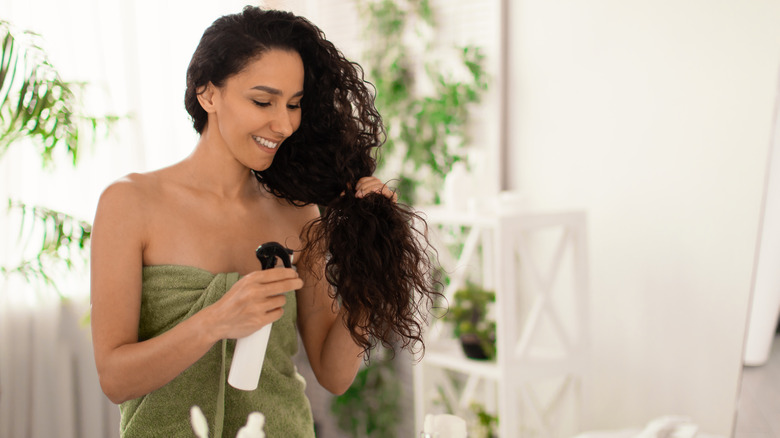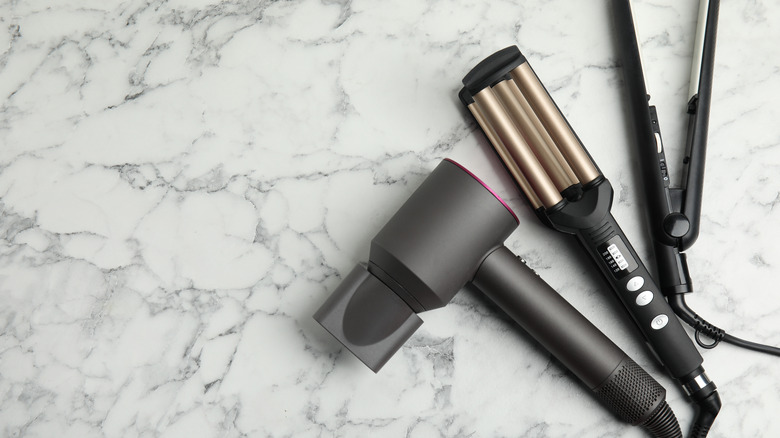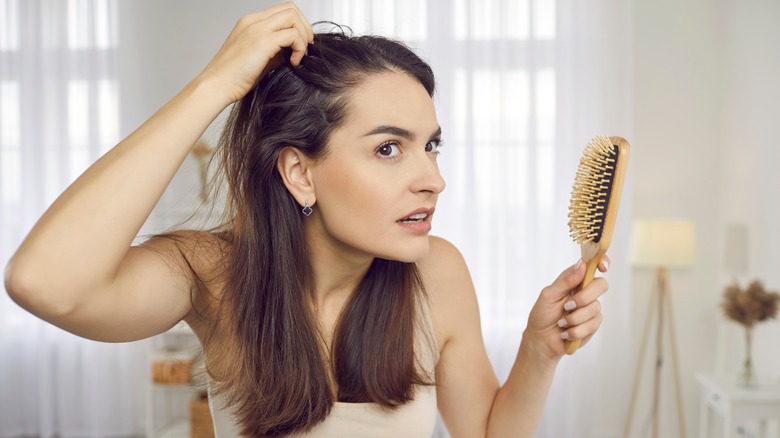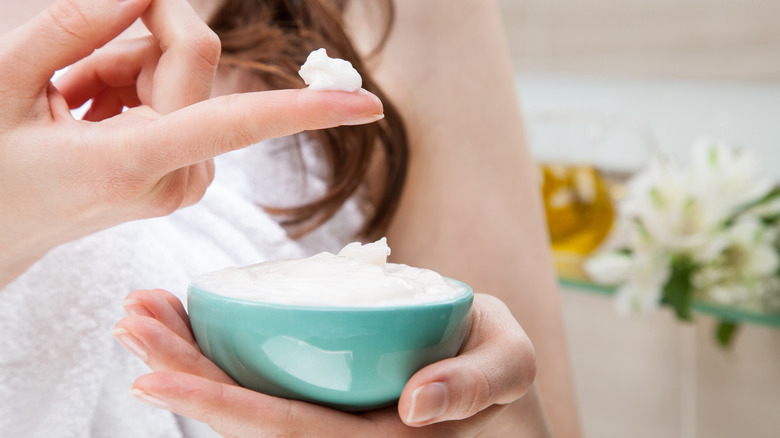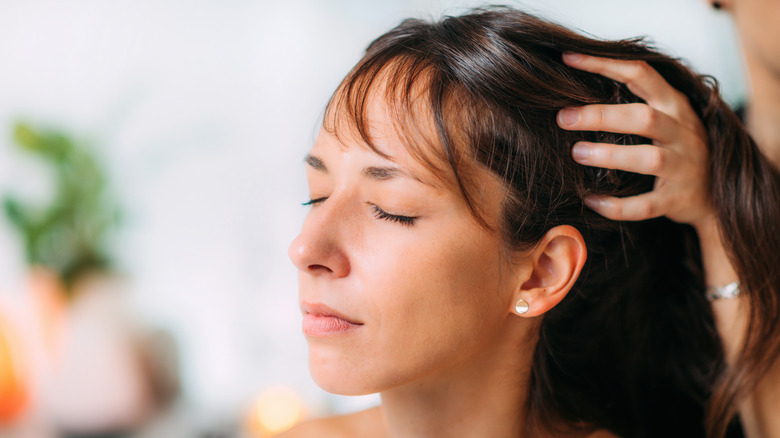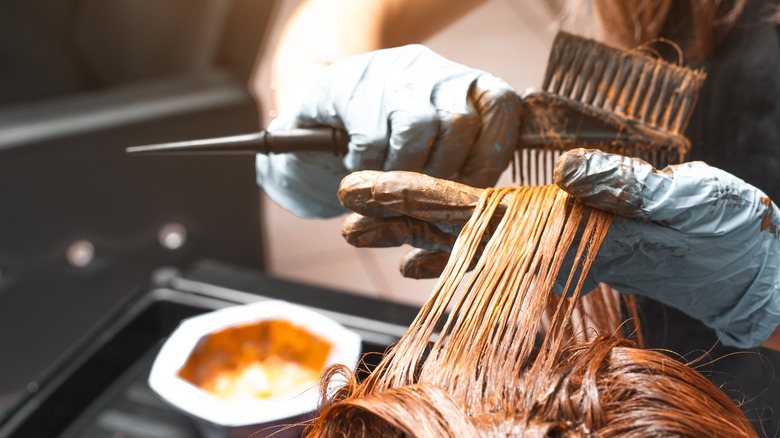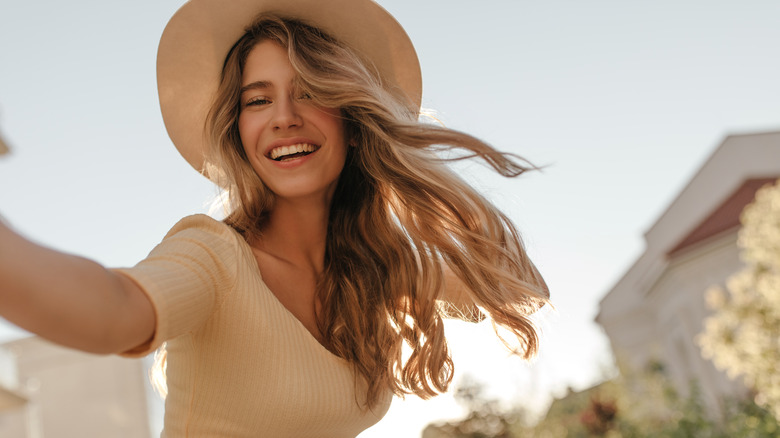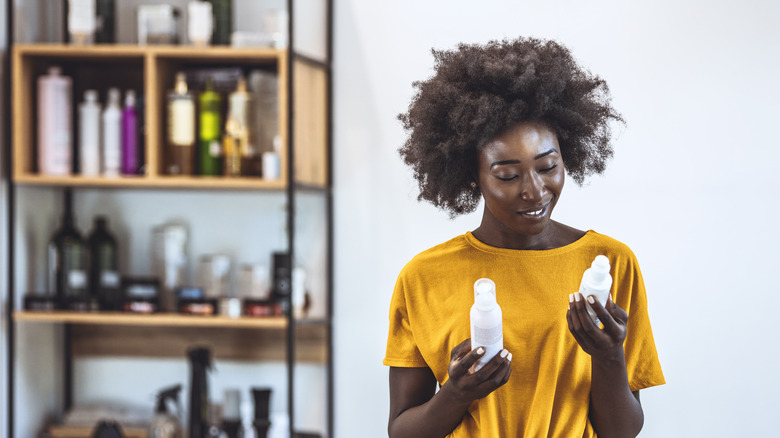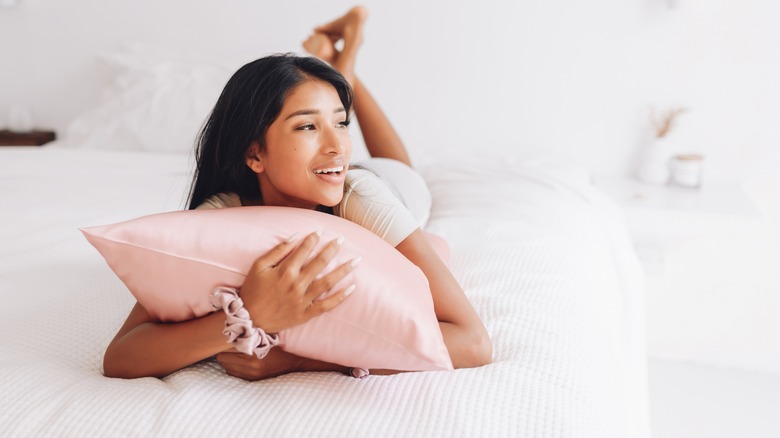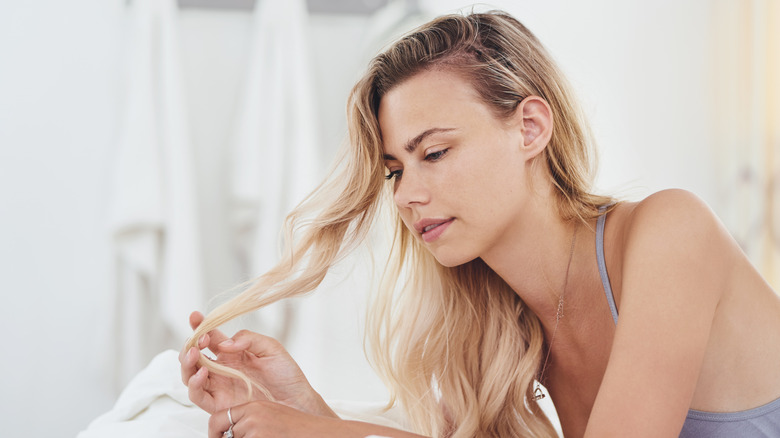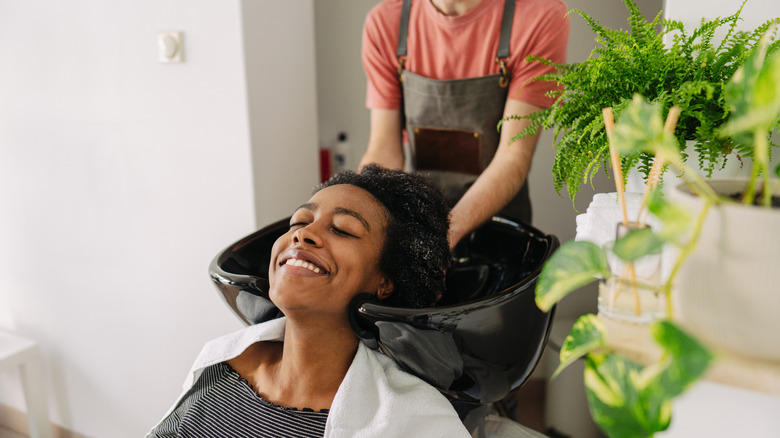The Tips You Need To Know To Get The Softest Hair Of Your Life
Most of us can agree that as tedious as haircare may be, having soft hair is really satisfying. Soft hair isn't only nice to touch; it says a lot about the health of the hair. In addition to being soft, healthy hair is smooth, shiny, and easy to handle. It's also free of damage, frizz, dryness, weakness, and split ends. Achieving soft hair, therefore, means working on the health of your locks, which depends on the integrity of each layer of the hair. The outer hair cuticle is protective, and determines hair shine and smoothness. The inner hair cortex retains moisture and contains keratin, a protein that gives hair its strength and body, per a 2007 study published in the Journal of Investigative Dermatology. All of these elements come together to produce healthy tresses that feel soft and even.
To a certain degree, the softness of your hair depends on your genes and natural hair texture, which you can't change. But you can still improve how soft it is with proper maintenance. This involves minimizing damage and using techniques that encourage the growth of soft hair, including using the right products and avoiding practices that harm your hair.
Get the basics of shampooing right
Everyone knows how to shampoo — right? Wrong. Shampooing seems easy, but you could make little mistakes that may affect the softness of your hair. For starters, over-shampooing your hair strands makes them hard, dry, and staticky. Instead, concentrate on your scalp. That's where all the dirt and grease builds up, per the American Academy of Dermatology Association (AAD).
The type of shampoo to use and the number of washing rounds you need depends on your individual hair needs. Those with drier hair, for example, may benefit from a hydrating shampoo, while those with finer hair can opt for a volumizing shampoo. But regardless, a good shampoo should remove dirt, sweat, scales, hair product, and just enough oil to keep the hair clean, smooth, soft, and shiny (via a 2015 study published in the Indian Journal of Dermatology). This feat is obviously achieved better by some shampoos than others. As for how often you should be washing your hair, everyone is different. Your hair may become dry if you wash it too often, so if you don't have oily hair or a scalp condition, consider increasing the time between washes. Finding the right routine for you is a matter of trial and error, and responding to how your hair feels each time.
Don't forget to condition
If you want soft hair, never skip conditioning. Merely shampooing will leave your hair rough, dry, dull, and frizzy due to the scrubbing and shampoo chemicals. Conditioners balance out some of the cleaning agents in shampoos, add moisture and oils to the hair, and repair any hair damage. This all makes the hair softer, better looking, and easier to brush and style. Conditioners also protect the hair from environmental damage as you go about your day, according to a 2023 study published in Polymers.
For extra smooth and soft locks, a technique to try is co-washing, or washing your hair with conditioner only and forgoing shampoo. As the co-founding managing director of Afrocenchix Rachael Corson, LLB Hons, MSc, notes to Healthline, co-washing is "a method of deep hydration, rather than a way to cleanse, as conditioners typically contain ingredients which hydrate and moisturize rather than cleanse." So the good ol' shampoo is still needed on some days to wash the hair, but for most washes, you can simply use conditioner only. If you choose to try this technique, use conditioners with proteins, and moisturizing agents — the good stuff that makes the hair soft. But avoid conditioners containing silicones as they coat the hair and can make it greasy. Co-washing might not be a good idea for folks with oily or finer hair.
Avoid hot water
For softer hair, turn down the heat. This might be a big adjustment if you wash your hair while having a hot shower. But that piping-hot water dries and weakens your hair, dries your scalp, and increases the likelihood of damage and frizz (via SkinKraft).
Rather than hot water, use warm water. It makes the job of your shampoo easier by dissolving grime, which is helpful for those with oily hair. Warm water also helps to unclog your pores and increases blood flow to your scalp. Cool water also has perks. Your hair doesn't lose so much oil when you use cool water, which is helpful to those with a dry scalp. Cool water also seals the hair cuticle which leads to less frizz, flyaways, and overall smoother and softer hair. To get the best of both worlds, you can wash with warm water and rinse with cool water.
Dry wet hair with a cotton T-shirt or microfiber towel
Your hair is really fragile when it's wet. So, how you handle your wet hair affects its strength, and by extension, how soft it is. It's best to soak up excess water with an old cotton T-shirt or a microfiber towel. Other towels do such a great job of absorbing all the moisture from the hair that it easily becomes frizzy, explains hairstylist Isabella Vázquez to Makeup.com. And frizz is the foe of soft hair. Vázquez adds that regular towels roughen up the hair cuticle and weaken the hair. Whereas, "the flat surface [of a T-shirt] allows water to sink in and slide over the hair."
Drying your hair doesn't end at using a smooth material; you still need to be gentle. It's best to squeeze water from your hair with your T-shirt. Then, you can wrap your hair with it to soak the remaining water, taking care not to tug on your ends.
Use a good post-wash product
Shampoo, condition, dry — this sums up the wash-time routine of most people. But throwing the right post-wash product into the mix can give your hair a little extra TLC. The pickings for post-wash products — from mousses to hair serums — are certainly not slim. So the choice depends on the kind of finish you desire.
Generally, mousses help to prevent frizz and make the hair more defined and smooth. If you want that slicked-back look with few flyaways, then grab a tube of hair gel. To up your hair shine, smoothness, and softness, consider using hair serums or leave-in conditioners. It might take some experimenting to get the right product or product combination. But it's important to note that your hair should be able to take whatever post-wash products you choose to use. For example, hair that is thin or fine might not be able to handle as many products as thick or coarse hair.
Be mindful of hot hair styling tools
Granted, hair straighteners, curling wands, and blow dryers give the hair a luxurious finish. But these tools can damage your hair if you use them a lot. Heat above 140 degrees Celsius can alter hair keratin (via Russh). Over time, this alteration can become permanent, leading to weaker hair strands and less elasticity. Heat also drains your hair of moisture and oil, and increases your chance of developing split ends, which leads to further loss of moisture. All these make the hair dull, spongy, and dry with time.
If you can't do without heat, take precautions to limit hair damage. This starts with investing in the right tools. Metal and plastic blow dryers tend to become too hot which makes the hair frizzy and staticky. Ceramic blow dryers are the better option. Also, go for a blow dryer that offers temperature control and has a cool shot button. These features are also important for hair straighteners and other tools. When using hot tools, it's best to set them as low as you can and use a heat-protectant spray.
Take care of your scalp
Don't hold out on scalp care if you want soft, healthy hair. Your scalp secretes sebum or oil which moisturizes the hair. Your scalp also supplies nutrients and blood to the roots of your hair, which helps it grow properly. So what does it take to have a healthy scalp? For one, you need to manage scalp conditions like dandruff, seborrheic dermatitis, atopic dermatitis, and psoriasis. These conditions affect the texture and strength of your hair, making it rough, dull, and brittle with time. Additionally, you need to avoid using harsh products that deplete moisture. Your shampoo method should be less of a vigorous scrub and more of a gentle massage (via Healthline).
For extra support to your scalp, consider using a scalp scrub to exfoliate for similar benefits that exfoliation has on the skin. It can unclog your hair follicles, stimulate hair growth, and promote healthy hair overall, especially if you have oilier or finer hair.
Try a hair mask
Think of a hair mask like a salve for your hair. Good hair masks infuse your hair with vital nutrients and oils. They also moisturize and condition the hair. This increases the softness, strength, and luster of your hair, and improves your scalp health (via SkinKraft).
You can get a hair mask formulated for your hair type. Or you can make one yourself from common items like bananas, eggs, avocados, aloe vera, rice water, yogurt, pumpkin, mayonnaise, honey, essential oils, and other carrier oils like olive, jojoba, or coconut. If you choose to make your hair mask, there are some things to keep in mind. First off, you need a recipe with the right proportion of ingredients. You should also remember to dilute essential oils in a carrier oil. Be mindful of the nature of the ingredients used in your hair mask. For instance, perishable materials can go bad if left too long. Some ingredients are not meant for daily use. For instance, rice water and yogurt can cause excessive buildup when used every day, while mayonnaise and olive oil can block the pores and potentially cause breakouts if used too often (via Mane Addicts).
Massage your hair with hair oils
Massaging your hair and scalp with a good hair oil can help improve the texture of your hair, especially if it easily gets dry. A sweet bonus is that a scalp massage can be really relaxing. Hair oils act as emollients. This means that the best hair oils will soften, smooth, and moisturize the hair. There are many great moisturizing hair oils such as almond, sesame, mustard, olive, coconut, amla, castor, and fenugreek oil (via a 2022 study published in the International Journal of Trichology).
Almost every hair type can benefit from using hair oils, including those with an oily scalp, notes stylist David Lopez to Coveteur. Performing a hair oil massage is as easy as squirting a few little drops of your chosen oil and working out the kinks and knots of your scalp as you deem fit. An additional benefit of a scalp massage is that it stimulates blood flow to the scalp, stylist Charlotte Mensah tells the site. But be careful to avoid that greasy look that comes with using too much oil. To apply the oil evenly, use only a few drops at a time and work in sections. Alternatively, you can wash off excess oil after your massage.
Avoid over-processing your hair
There are lots of hair-processing methods — coloring, bleaching, perming, or relaxing. These treatments can make your hair more manageable or simply give you a fresh look. But they get a bad rap because they make use of chemicals capable of altering the structure and chemical composition of the hair. Over time, these changes reduce the ability of the hair to hold moisture, damage the cuticle, and alter the structure of keratin. At first, the hair loses its softness and luster, and later, its strength and elasticity. Ultimately these treatments make your older hairs dry and brittle, according to the 2023 study published in Polymers.
To minimize damage to processed hair, the AAD advises against frequent treatments, especially during the drier winter months. You should also avoid getting more than one treatment at a time. But if you must, you should perm or relax your hair at least two weeks before you color it. You should also take hair conditioning and sun protection seriously if you process your hair. These would help you maintain some level of softness through the damage.
Protect your hair from harsh weather and pollutants
Ever had a bad hair on a humid day? Then you know exactly how the weather can affect your hair. High humidity is a problem, especially for folks with porous or curly hair. The hair tends to absorb too much moisture, which makes it rough and puffy. For folks with fine, straight, and less porous hair, moisture can weigh down on the hair, making it flat (via Better Not Younger). Apart from humidity, your hair could be affected by temperature, ultraviolet (UV) rays, and environmental pollutants.
Ultraviolet rays can bleach the hair and damage cuticles, leading to split ends. They also damage keratin, which affects the strength of hair. This all makes the hair dry, brittle, dull, and hard, per the 2023 study published in Polymers. Using a hat or products with UV protection can be helpful. You also need to protect your hair from pollutants, which you can achieve by incorporating more antioxidants into your diet and haircare routine. They deplete moisture from the hair leading to hair frizz, weakness, dryness, and roughness. Pollution also causes split ends, increases hair loss, and ages the hair (via Dot and Key).
Use products made for your hair type
With a million hair care products on the market, knowing your hair type can save you from so much confusion about what to use. Certain hair products are for specific hair types and using the wrong one can affect your hair softness.
For example, if you use a shampoo for oily hair when you have dry hair, your hair can become extremely dry and rough. Another mistake could be using a clarifying or deep-cleaning shampoo when you don't have so much product buildup, according to a 2010 study published in the International Journal of Trichology. Folks with dry hair usually benefit from two-in-one shampoos as they prevent excessive loss of oils. Deep-conditioning products are also great for those with dry hair to keep the hair moisturized for longer periods. Also, if your hair tends to get frizzy, you should go for anti-frizz products to get that smooth and soft finish.
Get the right nutrients in your diet
Righting your diet is a great way to maintain your hair health in the long term. A poor diet is likely to affect your hair because your body will prioritize nourishment of important organs rather than the hair (via Hair Scientists). What's tricky about nutrient deficiencies is that you may not notice the effect on the hair until it grows. Nutrient deficiencies cause the hair to become dry, rough, hard, weak, and dull. On the other hand, having a balanced diet can improve your hair health.
A balanced diet typically contains a mix of fruits, vegetables, grains, and good sources of protein and fats. Some nutrients important for healthy hair include omega-3 fatty acids, proteins, vitamin B12, and iron, which can be absorbed from fish and dark-green vegetables. These nutrients help reduce scalp dryness and increase hair shine. Vitamins A and C, which can be easily absorbed from dark-green vegetables, help improve sebum production. To avoid brittle and breakage-prone hair, you need protein from good sources as well as adequate amounts of selenium, zinc, vitamins D and E, biotin, niacin, and other B vitamins.
Use a silk or satin pillowcase
Retiring your cotton sheets for silk or satin might be worth the splurge for soft hair. Silk isn't just soft on your skin; it's soft on your hair, too. It prevents static and friction — which can lead to hair frizz and tangles. Speaking to Martha Stewart, celebrity stylist Justine Marjan explains, "Friction from cotton can disrupt the cuticle layer, leading to frizz, breakage, sleep crease, and dry strands." Marjan adds, "Silk doesn't absorb or pull moisture from your skin the way traditional cotton pillowcases do, leaving hair hydrated and frizz-free."
Satin is a cheaper alternative to silk that's just as good, as long as it's a high-quality satin. Silk is a by-product of silkworms while satin is a weave made from silk, polyester, or nylon. Both materials can protect your hair, keep it soft, and maintain your hairstyle. An alternative to getting a pillowcase is using a silk or satin scarf or hair bonnet. Just make sure to get one that is comfy and doesn't slip off at night.
Tackle split ends
Split ends are the enemies of soft hair; they make the tips of the hair fray like the bristles of an old brush. This makes your hair less sleek and more puffy and frizzy. The splitting exposes the inner layer of your hair, leaving it open to lose moisture, which makes it rough, dry, and dull (via We Colour).
The tips of your hair split because they are the oldest, weakest, and likely the most damaged part of the hair. This damage can come from a number of factors, from the environment to brushing to the chemicals in hair products (via Healthline). Unfortunately, the best way to get rid of split ends is quite final — to cut them off. Leaving split ends leads to further splitting and ultimately, to dead ends. Alternatively, you can conceal split ends with hair masks and leave-in conditioners. These products help with hair softness, but don't remedy split ends.
Manage your hair with a professional stylist
Do-it-yourself haircare is great because you take full control of the ingredients and methods used to achieve your soft hair goals. But they require a lot of commitment, research, and concocting skills. And for some folks, the hassle just isn't worth it. Thankfully, most good hairstylists are more than happy to help you achieve your hair goals. All you have to do is communicate them. You can choose to leave your haircare totally to your stylist or just go in once in a while to supplement your efforts.
The number-one benefit of going to a stylist is that they can offer professional advice on how to get soft hair based on your hair type. You can get good product recommendations, too. It also helps that there are a variety of services at the salon. So, you can make a day of going to the salon and give yourself a good pampering while improving your hair health.

